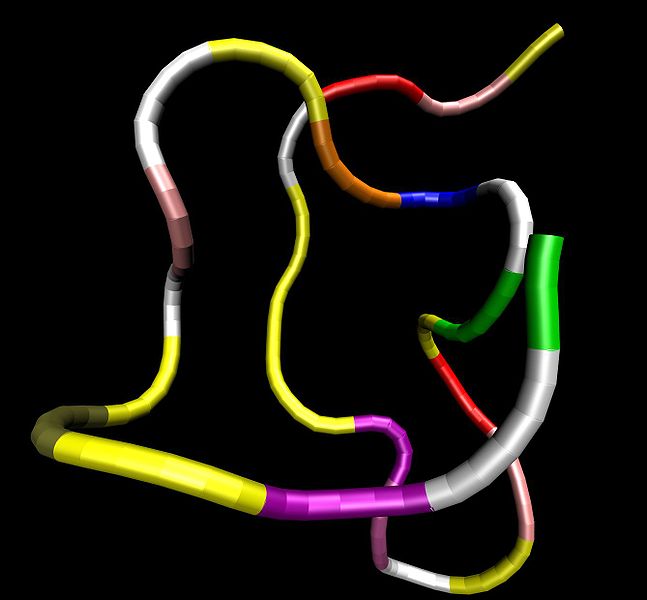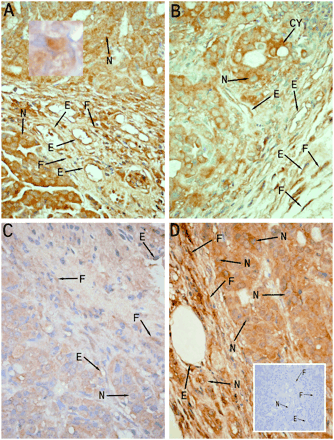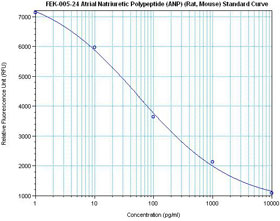|
|
|
Atrial Natriuretic Peptide (ANP) |
Atrial natriuretic peptide (ANP), atrial natriuretic factor (ANF), atrial natriuretic hormone (ANH), or atriopeptin, is a powerful vasodilator, and a polypeptide hormone secreted by heart muscle cells. It is involved in the homeostatic control of body water, sodium, potassium and fat (adipose tissue). It is released by muscle cells in the upper chambers (atria) of the heart (atrial myocytes) in response to high blood pressure. ANP acts to reduce the water, sodium and adipose loads on the circulatory system, thereby reducing blood pressure.
ANP is a 28-amino acid peptide with a 17-amino acid ring in the middle of the molecule. The ring is formed by a disulfide bond between two cysteine residues at positions 7 and 23. ANP is closely related to BNP (brain natriuretic peptide) and CNP (C-type natriuretic peptide), which all share the same amino acid ring. ANP was discovered in 1981 by a team in Kingston, Ontario, Canada after they made the seminal observation that injection of atrial (but not ventricular) tissue extracts into rats caused copious natriuresis.
| 
|
ANP is produced, stored and released by cardiac myocytes of the atria of the heart. It is released in response to atrial stretch and a variety of other signals induced by hypervolemia, exercise or caloric restriction. The hormone is constitutively expressed in the ventricle in response to stress induced by increased afterload (e.g. increased ventricular pressure from aortic stenosis) or injury (e.g. myocardial infarction).
ANP is secreted in response to:
- Atrial distention, stretching of the vessel walls
- Sympathetic stimulation of β-adrenoceptors
- Raised sodium concentration (hypernatremia), though sodium concentration is not the direct stimulus for increased ANP secretion
- Angiotensin-II
- Endothelin, a potent vasoconstrictor
The atria become distended by high extracellular fluid and blood volume, and atrial fibrillation. Notably, ANP secretion increases in response to immersion of the body in water, which causes atrial stretch due to an altered distribution of intravascular fluid. ANP secretion in response to exercise has also been demonstrated in horses. |

Atrial natriuretic peptides (ANPs) are a family of peptide hormones, e.g., ANP, long-acting natriuretic peptide, vessel dilator, and kaliuretic peptide synthesized by the ANP gene. Brain natriuretic peptide (BNP) and C-type natriuretic peptide are also members of this family but are synthesized by separate genes. Within the kidney, the ANP prohormone's posttranslational processing is different from that of other tissues, resulting in an additional four amino acids added to the NH2 terminus of ANP (e.g., urodilatin). Each of these natriuretic and diuretic peptides increases within the circulation with acute renal failure (ARF). Renal transplantation but not hemodialysis returns their circulating concentrations to those of healthy individuals. BNP and adrenomedullin, a 52-amino acid natriuretic peptide, have beneficial effects on glomerular hypertrophy and glomerular injury but do not improve tubular injury (i.e., acute tubular necrosis). Vessel dilator ameliorates acute tubular necrosis with regeneration of the brush borders of proximal tubules. Vessel dilator decreases mortality in ARF from 88 to 14% at day 6 of ARF, even when given 2 days after renal failure has been established.
Vesely DL. Am J Physiol Renal Physiol. 2003
Aug;285(2):F167-77
Four cardiac peptide hormones, i.e., vessel dilator, long acting natriuretic peptide (LANP), kaliuretic peptide, and atrial natriuretic peptide (ANP) synthesized by the same gene decrease within 24 hours up to 97% the number of human breast, colon, pancreatic, and prostate adenocarcinoma cells as well as human small-cell and squamous carcinomas of the lung cells. These peptide hormones completely inhibit the growth of human pancreatic adenocarcinomas growing in athymic mice. Immunocytochemical investigations have revealed that LANP, vessel dilator, kaliuretic peptide and ANP localize to the nucleus and cytoplasm of human pancreatic adenocarcinomas, which is consistent with their ability to decrease DNA synthesis in the nucleus of this cancer mediated by the intracellular messenger cyclic GMP. These peptide hormones also localize to the endothelium of capillaries and fibroblasts within these cancers. These are the first growth-inhibiting peptide hormones ever demonstrated to localize to the nucleus. Their ability to decrease the activation of growth promoting substances such as Extracellular Receptor Kinase (ERK)-1/2 and Nuclear Factor Kappa Beta (NFkappaB) suggests that in addition to inhibiting DNA synthesis their ability to decrease the activation of growth promoting substances helps to mediate their ability to inhibit the growth of human cancers.
Saba SR, Vesely DL.
Histol Histopathol. 2006 Jul;21(7):775-83.
Tissue Sample |
Rat and mouse heart tissues |
Fixative |
10% formalin |
Embedding |
Paraffin |
Negative Control |
No primary antibody |
Pretreatment |
N/A |
Blocking |
3% H2O2, 2% Normal Goat Serum |
Primary Antibody |
Rabbit anti-ANP, Prepro (26-55) (H) antibody (Cat. No.: H-005-19) |
Optimal Dilution |
1: 500 |
Secondary Antibody |
Goat Anti-Rabbit IgG, Biotinylated (1:400), 30 min |
Amplification |
Streptavidin-HRP (Vector), 1:400, 30 min |
Detection System |
HRP |
Substrate |
DAB (Sigma), 3 min |
Counterstained |
Hematoxylin, 30 sec |

Immunoperoxidase localization of vessel dilator
[Rabbit Anti-Atrial Natriuretic Peptide (ANP) (56-92)-Prepro (Human) Antibody,
Cat.No. (H-005-20) within the kidney demonstrating staining through out the kidney
but of increased intensity of staining in the proximal tubules (T) of this
normal rat kidney. Original magnification x60. Primary antibody diluted 1:800.

Immunoperoxidase localization of vessel dilator, long-acting natriuretic peptide (LANP) [Rabbit Anti-LANP/ANP, Prepro (26-55) (Human), Cat. No.: (H-005-19), kaliuretic peptide [Rabbit Anti-Atrial Natriuretic Peptide (ANP) (104-123)-Prepro (Human), Cat. No.: (H-005-22) , and atrial
natriuretic peptide (ANP) [Rabbit Anti-Alpha-ANP (1-28) (Human) Antibody, Cat. No.: H-005-06
within human pancreatic adenocarcinomas with each of these peptide hormones strongly localizing to cytoplasm (Cy), nucleus (N),
endothelium (E), and fibroblasts (F). The light blue stain in the fibroblasts is the nuclei of the fibroblasts.
(A) Vessel dilator
treated,
(B) LANP treated,
(C) kaliuretic peptide treated,
and (D) ANP treated.
Primary antibody of each peptide was diluted 1:800.
Original magnification x60. The inset in (A) is an isolated nuclei illustrating that vessel dilator has immunoperoxidase staining
within the nucleus. The inset in (D) is a negative control using the human pancreatic adenocarcinoma with substitution of the primary
antibodies with normal rabbit serum.
|
| | 
|  |
Linear Range: 0.12-1.32 ng/ml
|
Linear Range: 0.10-1.51 ng/ml
|
|
| |

|  |
Linear Range: 14.8-338 pg/ml
9 times more sensitive than normal EIA kits
|
Linear Range: 20.7-241 pg/ml
6 times more sensitive than normal EIA kits
|
|
| | |

|  |  |
Linear Range: 0.2-5.5ng/ml
|
Linear Range: 10.5-776 pg/ml
20 times more sensitive than normal EIA kits
| Linear Range: 7.4 - 251 pg/ml
27 times more sensitive than normal EIA kits
|
 


 
Four peptide hormones [e.g., atrial natriuretic peptide (ANP),
long-acting natriuretic peptide (LANP), vessel dilator, and kaliuretic peptide] are synthesized by this gene. Each of these
peptide hormones has biological effects, e.g., natriuresis and diuresis, mediated via the kidney. LANH, long-acting natriuretic
hormone (a different nomenclature for LANP); a.a., amino acids.
Vesely DL. Am J Physiol Renal Physiol. 2003
Aug;285(2):F167-77

Each of the sequences are the human sequences except for Dendroaspis natriuretic peptide (DNP), whose sequence is only known in the
snake. The brackets illustrate the location of cystine bridges that help to form a ring structure in a number of these peptides. BNP,
brain natriuretic peptide; CNP, C-type natriuretic peptide.
Vesely DL. Am J Physiol Renal Physiol. 2003
Aug;285(2):F167-77

Vessel dilator immunoperoxidase staining in the rat kidney reveals strong staining of the sub-brush border of proximal convoluted tubules (arrowheads in A and B), including a proximal tubule (A) originating directly from the top left portion of the glomerulus. The interstitial artery (C) had strong proANP-(31—67) staining of the elastica with moderate staining of endothelial cells (arrow) and media (*). The distal tubules and collecting ducts (arrows in A and B) had weak staining with no demonstrable staining in some of the collecting duct cells. Magnification: x940.
Vesely DL. Am J Physiol Renal Physiol. 2003
Aug;285(2):F167-77

Histology (hematoxylin and eosin) of human pancreatic adenocarcinoma illustrating capillaries (but not large blood vessels)
growing into ad enocarcinoma and numerous mitosis occurring. CAP= capillaries, n = nucleus of human pancreatic adenocarcinoma cell,
M= mitosis within adenocarcinoma cell, and F=fibroblasts with human pancreatic adenocarcinoma.
It is important to note that there are several cancer cells undergoing mitosis
in this very rapidly growing cancer. Original magnification x60
|
|
|
fsANP
%ANP%;%Atriopeptin%
|
|
|


